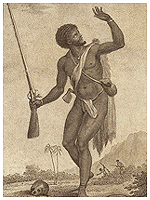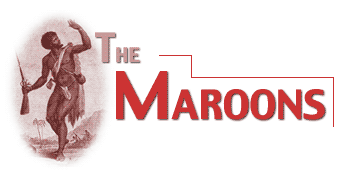R.C. Dallas’ History of the Maroons and Bryan Edwards’ On the Maroons provide good accounts of the Maroons of Jamaica. Both were written in the 18th century, when the Maroons were still prominent in the island, by whites who had frequent dealings with them. They not only give us an explanation of the Maroons’ culture, but they also provide us with a first hand account of their existence. This includes many interesting aspects of their lives, such as the way they lived, their habits, and their manners.
One should start by describing the basic aspects of their lives. The Maroon habitations were meager, to say the least. Their houses were built "for the convenience of a sloping ground to carry off the floods occasioned by heavy rains." Most were small cottages covered with thatch or long grass, usually with no floor but the ground itself. Some of the houses of the chiefs had shingle roofs and floored rooms. Surrounding these houses was a fence, "made of a prickly shrub, called the Pinguin".
Agriculture among the Maroons was not very complex at all, in part because they did not have a great dependence on it. The Maroons fulfilled most of their wants through hunting, and from their rewards for catching runaway slaves. The Maroons also raised fowls, and bred cattle and hogs. Nonetheless, they still grew fruits and vegetables. These included "plantain, Indian corn or maize, yams, cocoas, toyaus, and in short all the nutritious roots that thrive in tropical soils". The women did most of the cultivating, which included clearing the land. They did this by setting a fire around trees and leaving it to burn until the trunks of their own weight. Neither Dallas nor Edwards tells us why the women were the farmers. This, like many other aspects of their lives, was probably connected to the Maroons’ heritage in West Africa, where women were generally the farmers in a community or village. Edwards and Dallas almost certainly underrated the value of the women’s work to the Maroon camps. Despite what seems to be a very simple provision of food, they had some luxuries, provided by the woods. These included wild boar, ring-tailed pigeons and the land crab.
 Accounts by both Dallas and Edwards describe the Maroons as looking different from the rest of the Negroes on the island. As Dallas explains, they "displayed a striking distinction in their personal appearance, being blacker, taller, and in every respect handsomer". He attributes this to their constant exercise in climbing and descending the mountains, in pursuit of wild boars and runaway slaves. The Maroons, who looked "handsomer" to Dallas, and had "great bodily perfection" , according to Edwards, were muscular and strong men, constantly on the move through the rough terrain of the interior of Jamaica. They frequently hunted for wild boar, often selling the meat to buyers in the settlements on the coastal regions. When they were not doing this, they were searching the woods for runaway slaves, whom they would return dead or alive for a reward. Accounts by both Dallas and Edwards describe the Maroons as looking different from the rest of the Negroes on the island. As Dallas explains, they "displayed a striking distinction in their personal appearance, being blacker, taller, and in every respect handsomer". He attributes this to their constant exercise in climbing and descending the mountains, in pursuit of wild boars and runaway slaves. The Maroons, who looked "handsomer" to Dallas, and had "great bodily perfection" , according to Edwards, were muscular and strong men, constantly on the move through the rough terrain of the interior of Jamaica. They frequently hunted for wild boar, often selling the meat to buyers in the settlements on the coastal regions. When they were not doing this, they were searching the woods for runaway slaves, whom they would return dead or alive for a reward.
According to Edwards, the Maroons, "like all other savage nations, regarded their wives as so many beasts of burthen; and felt no more concern at the loss of one of them, than a white planter would have felt at the lost of a bullock". He further explains that polygamy was a common practice among them. Some men claimed two to six wives. Edwards also explains that the children were not treated well. He claims, "that it was not an uncommon circumstance for a father, in a fit of rage or drunkenness, to seize his own infant, which had offended him by crying, and dash it against a rock, with a degree of violence which often proved fatal." Edwards may well be exaggerating, as he was not fond of the Maroons, when he considered a threat to planter power. Further, Edwards claimed, that young women would be offered to visitors, with or without their consent for the purpose of prostitution. The guests of the Maroons were given a "hearty and boisterous kind of hospitality." On most of these occasions, a mock fight was a part of the entertainment and a variety of foods were served, including wild boar, land crabs, pigeons and fish.
The language of the Maroons, Edwards argued, "was a barbarous dissonance of the African dialects, with a mixture of Spanish and broken English." The Maroons also communicated by use of a horn, is known as the Abeng. Their use of the horn was remarkable, "they distinguished the orders that the sound conveyed." Dallas tells us "the Maroons had a particular call upon the horn for each individual, by which he was summoned from a distance, as easy as he would have spoken to by name, had he be near." Where religion was concerned, the Maroons, like their forefathers, believed that "Accompong was the God of Heavens, the creator of all things, and deity of infinite goodness." Dallas provides this information and adds that they neither offered sacrifices to him nor had any modes of worship. Edwards also speaks of the Maroons’ belief in the practice of obeah, a sort of "witchcraft." Allegedly some of the chiefs used obeah to to keep some of the younger men in subordination.

Marriages among the Maroons had no religious or juridical ceremonies. The consent of the woman to live with the man was sufficient and as previously stated, a man had as many wives as he pleased. Gifts of cloths were presented to the bride, and hogs and fowls to the groom. If they were to separate however, they were to return all the gifts bestowed unto them. Funeral procedures were simple among them and were much the same as the other blacks on the island. They would place the dead in a wooden coffin and sing prior to burial. Deaths were not more frequent to the Maroons than elsewhere. However, when they were able they saw the plantation doctors or "took simple herbs prescribed to them by their old women."
The Maroons of Jamaica lived a somewhat simple life in an exceptionally difficult terrain. However, they adapted well to the environment, where they made themselves as comfortable as possible. They were not savages running around in the forest, as many writers depcited them. They had for the most part created a way of life that reproduced African customs and traditions, while also incorporating new customs, manners and habits into their lives.
|





